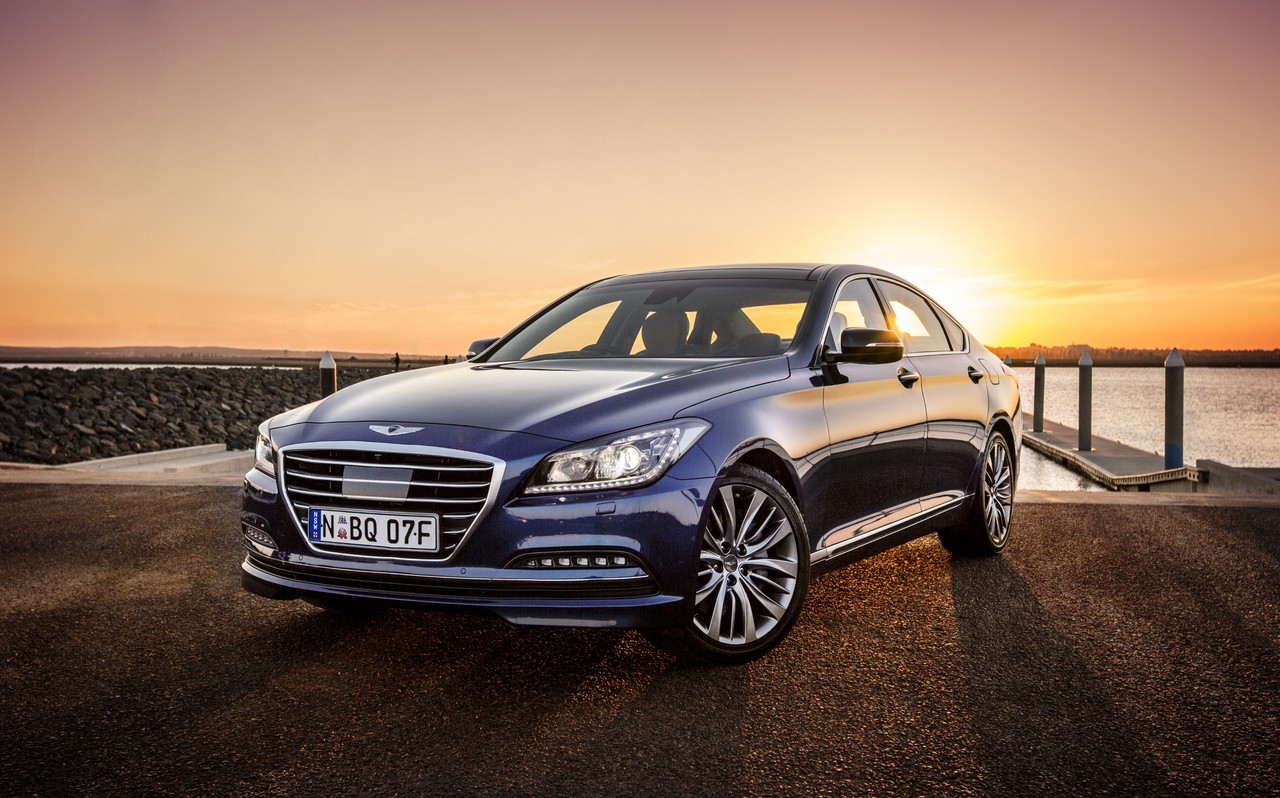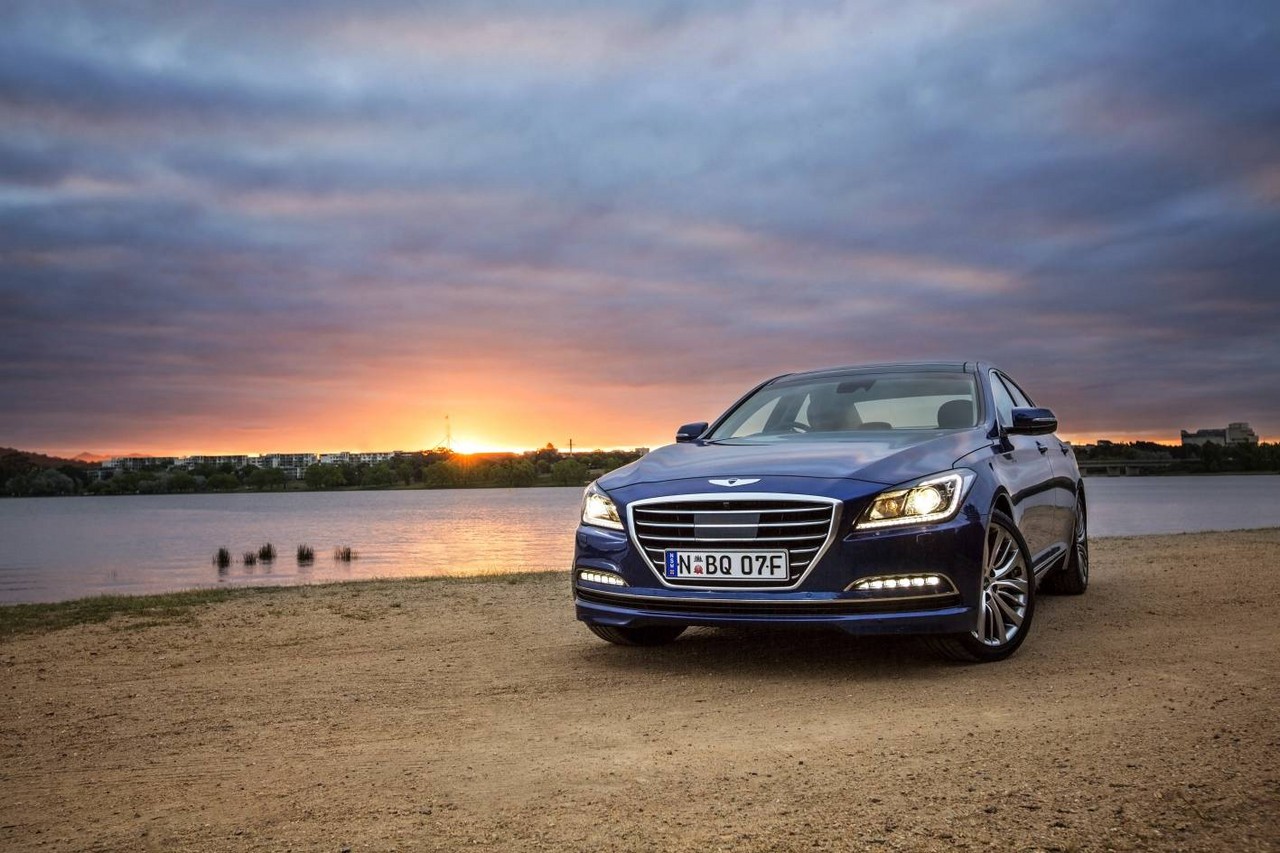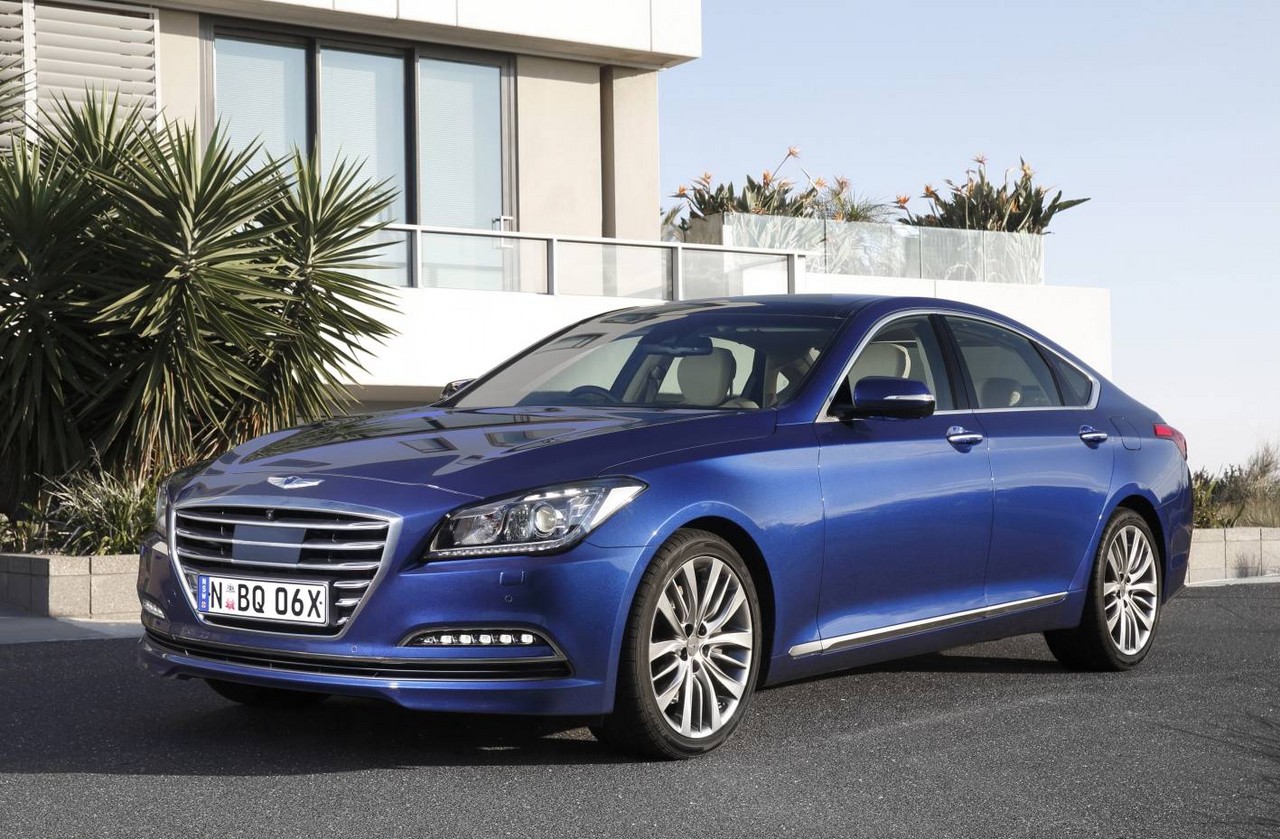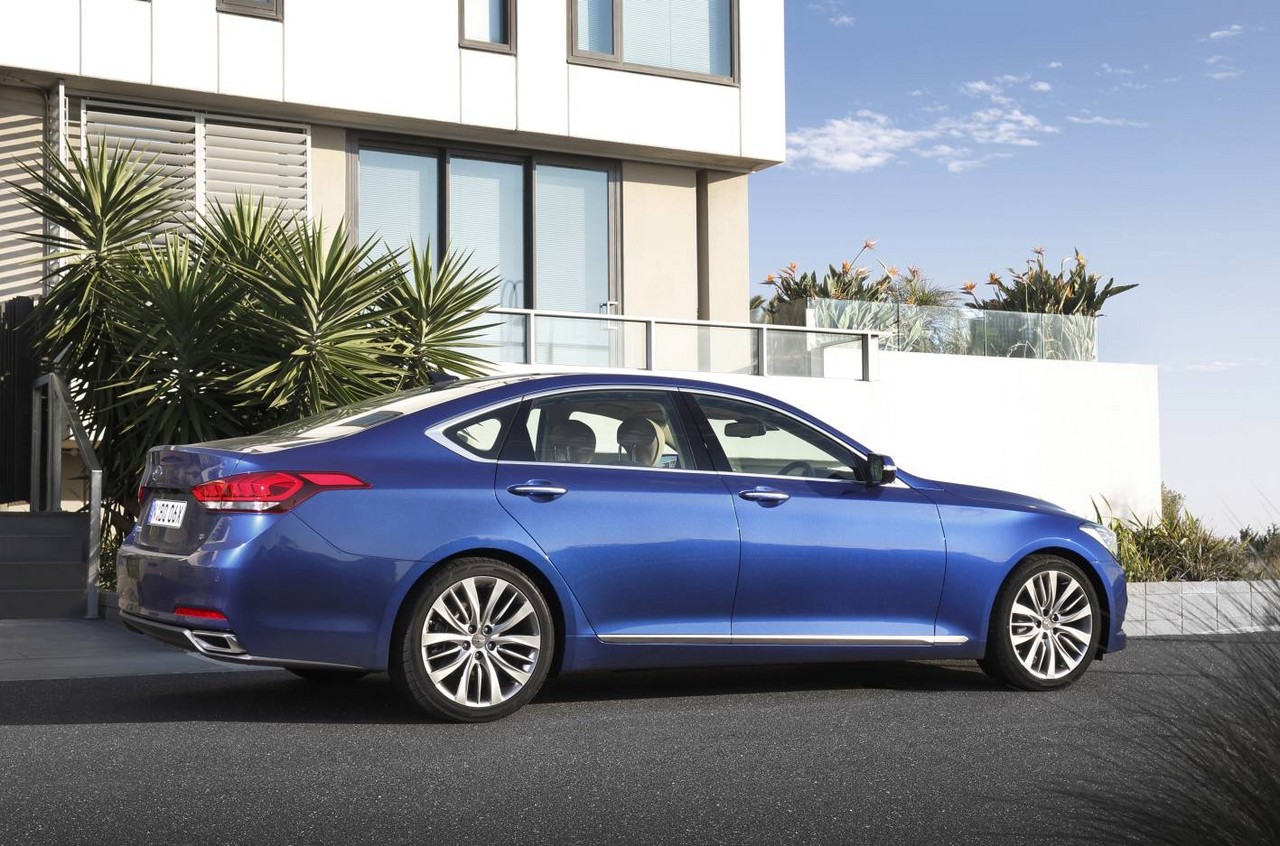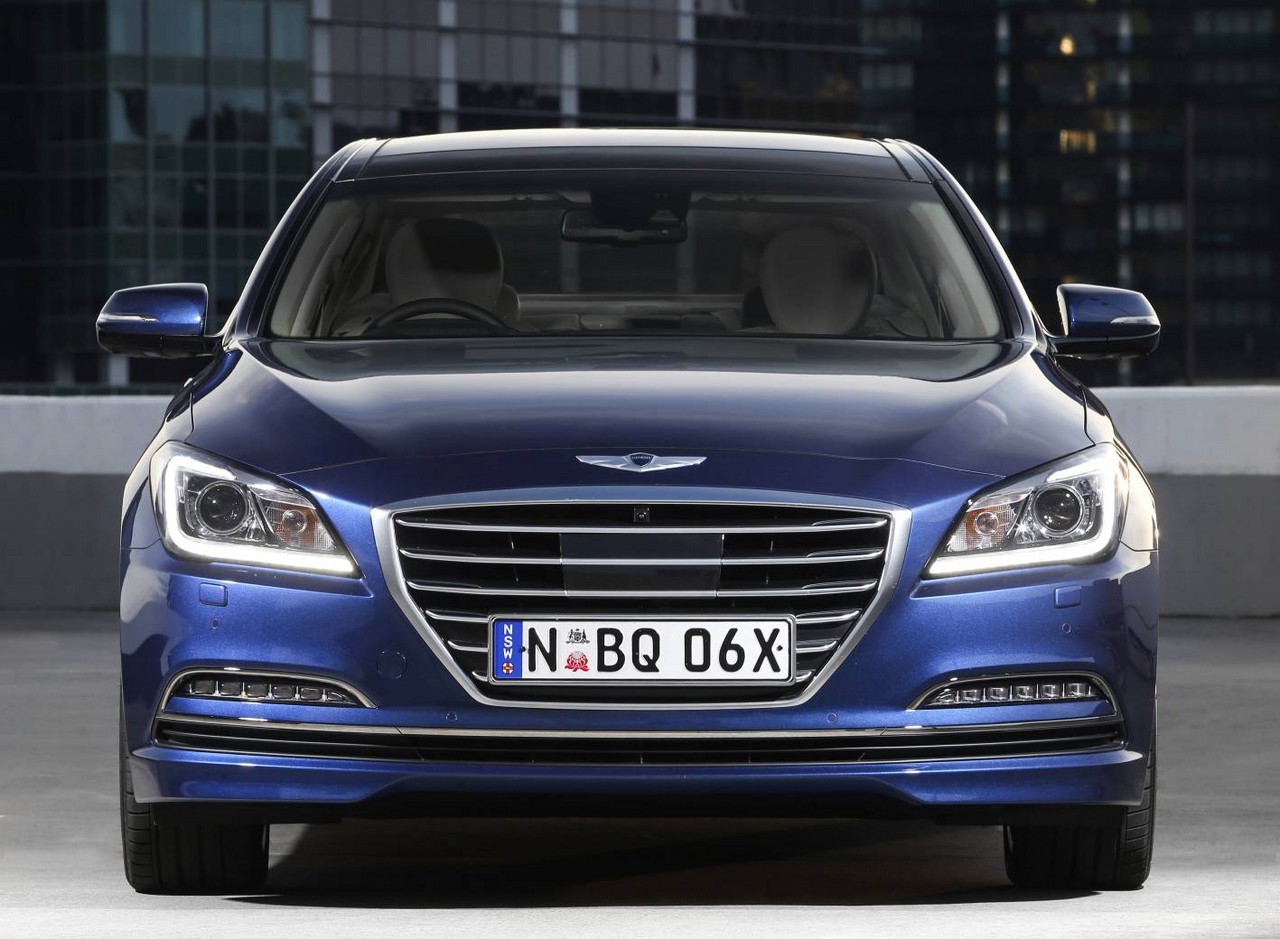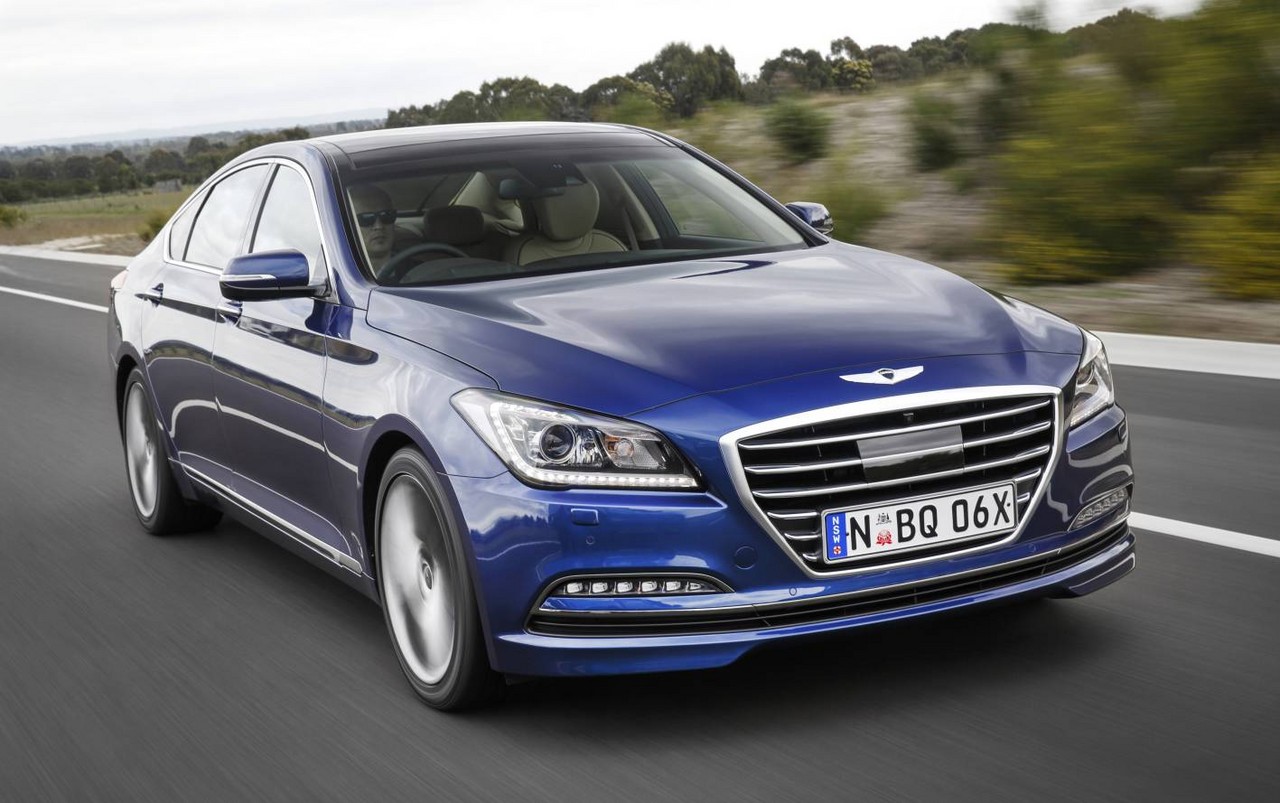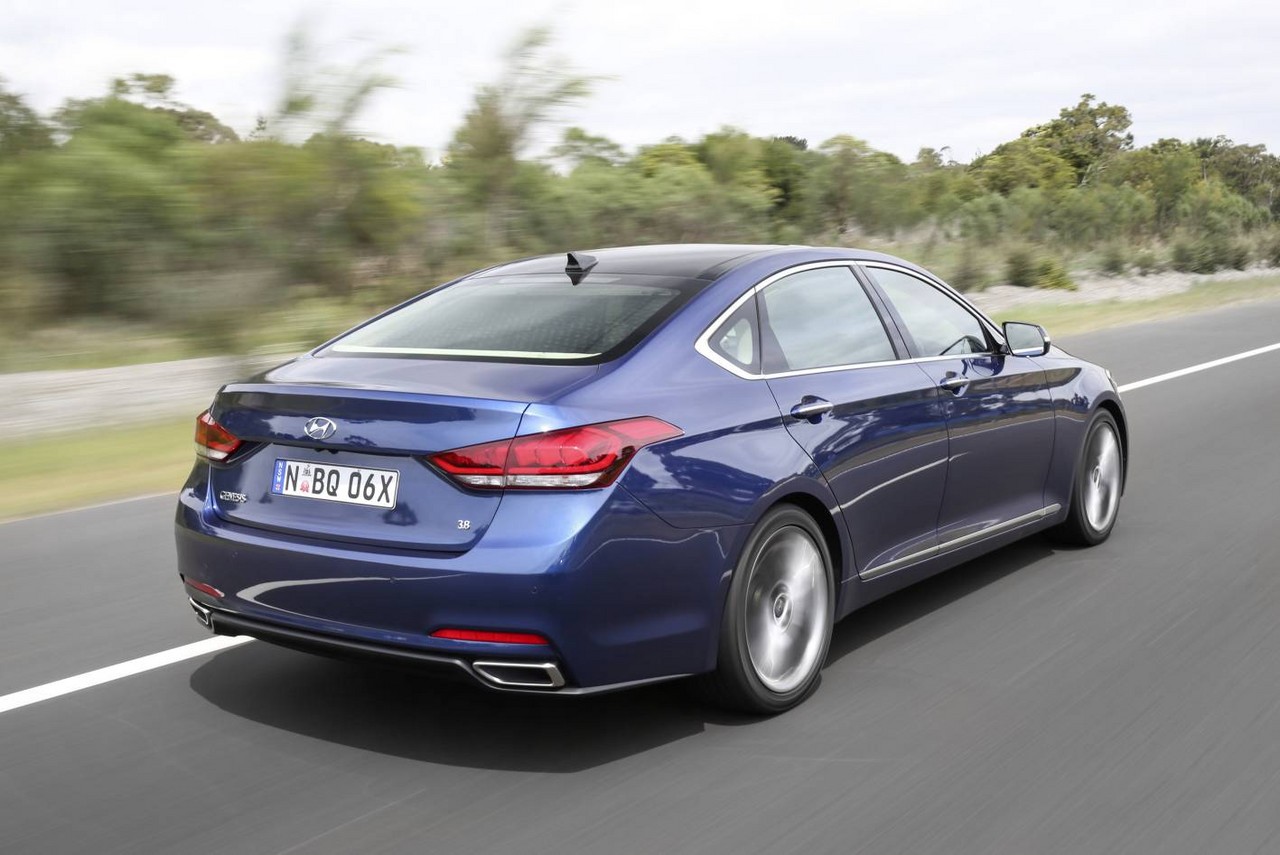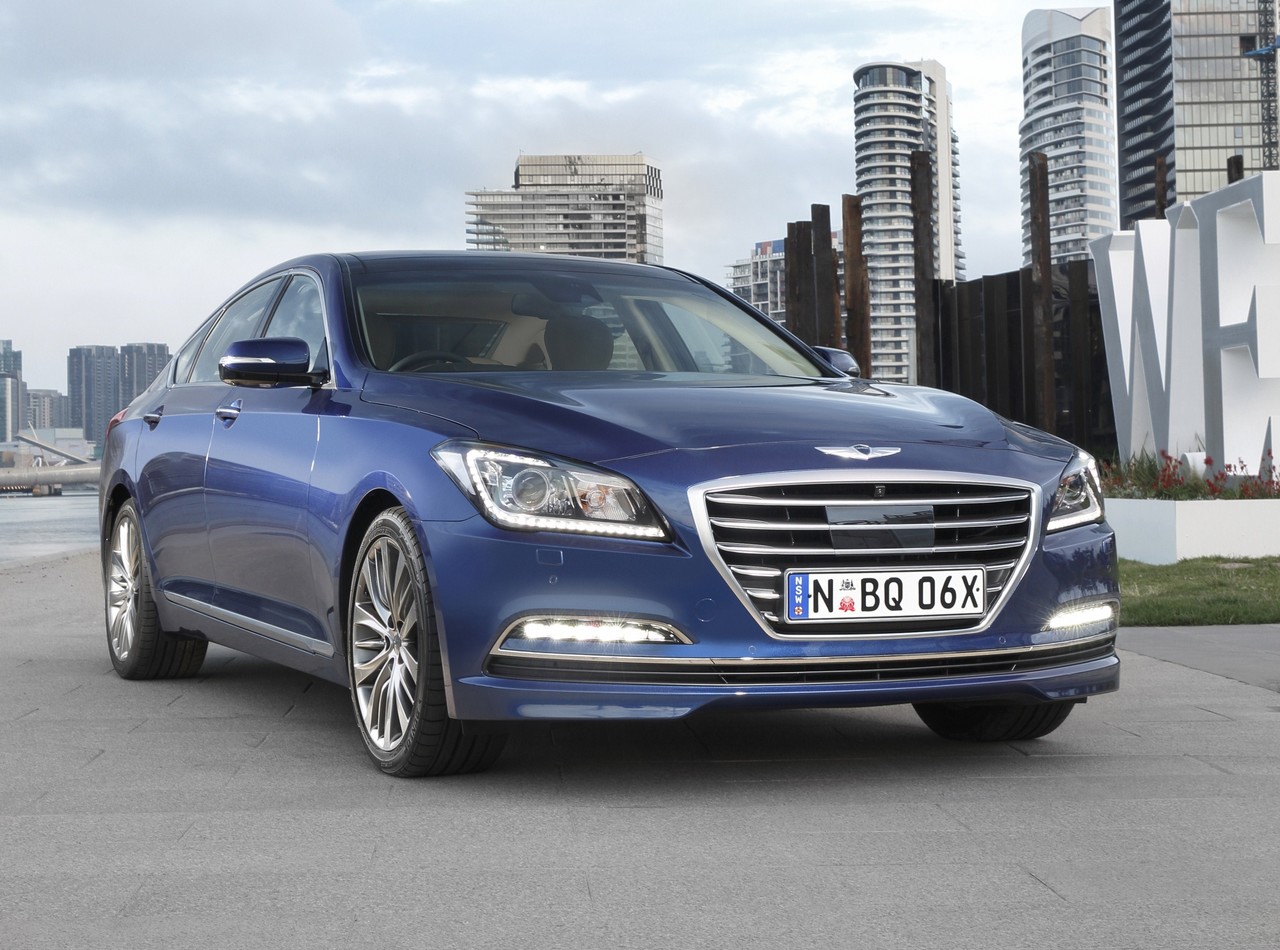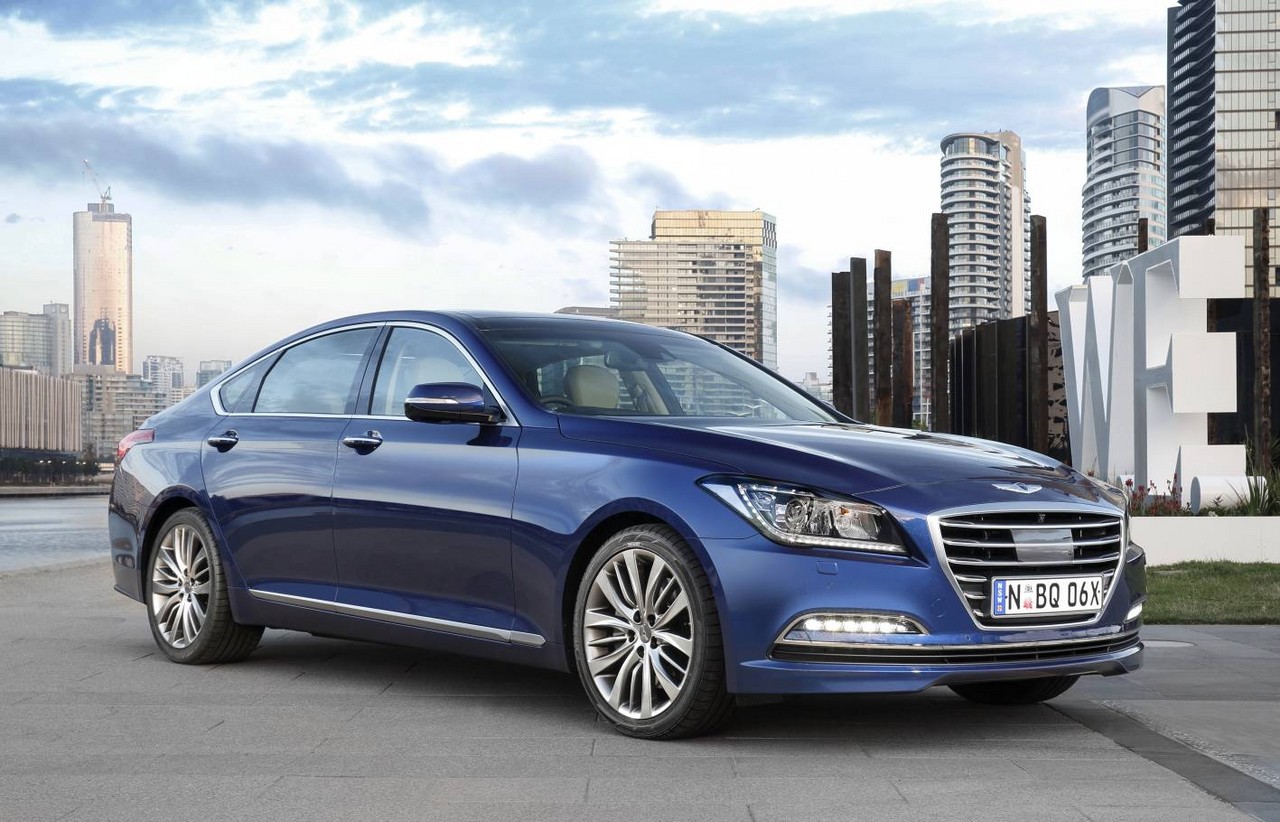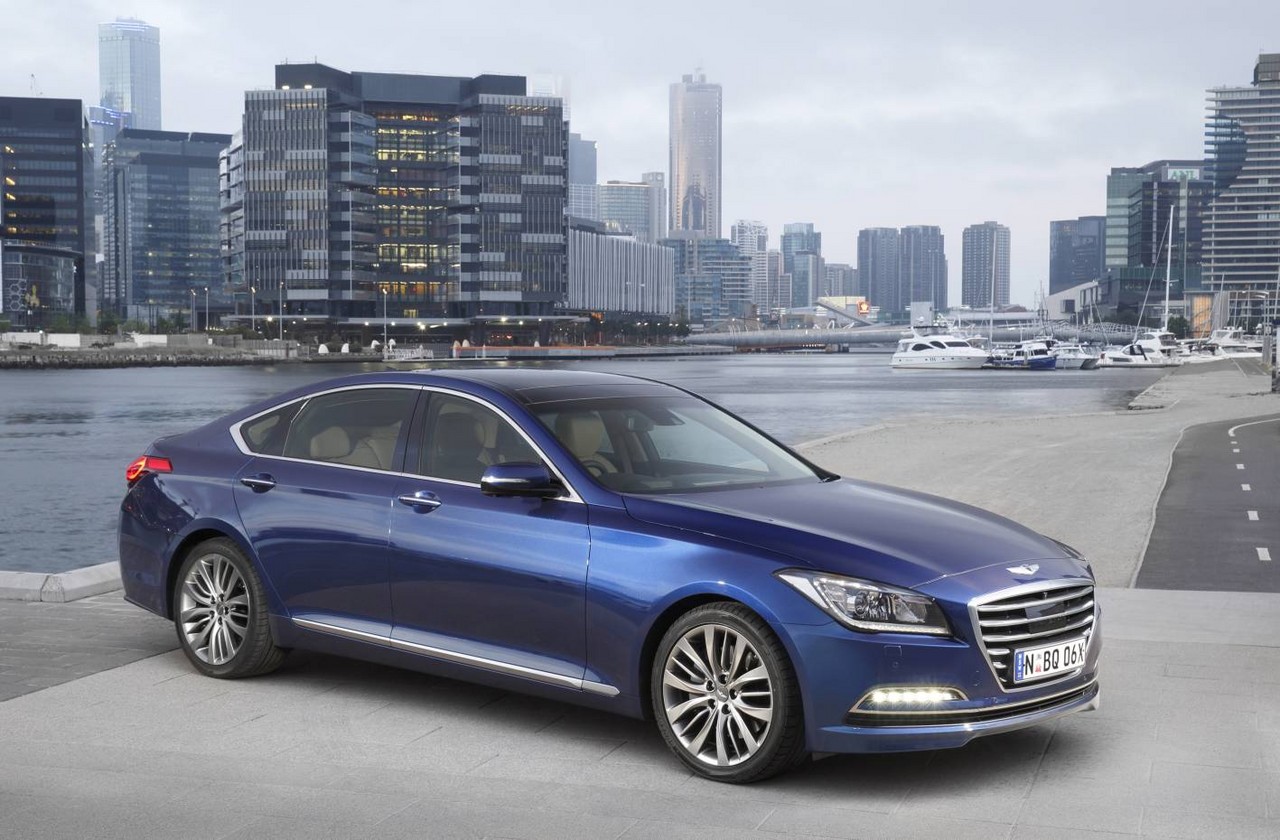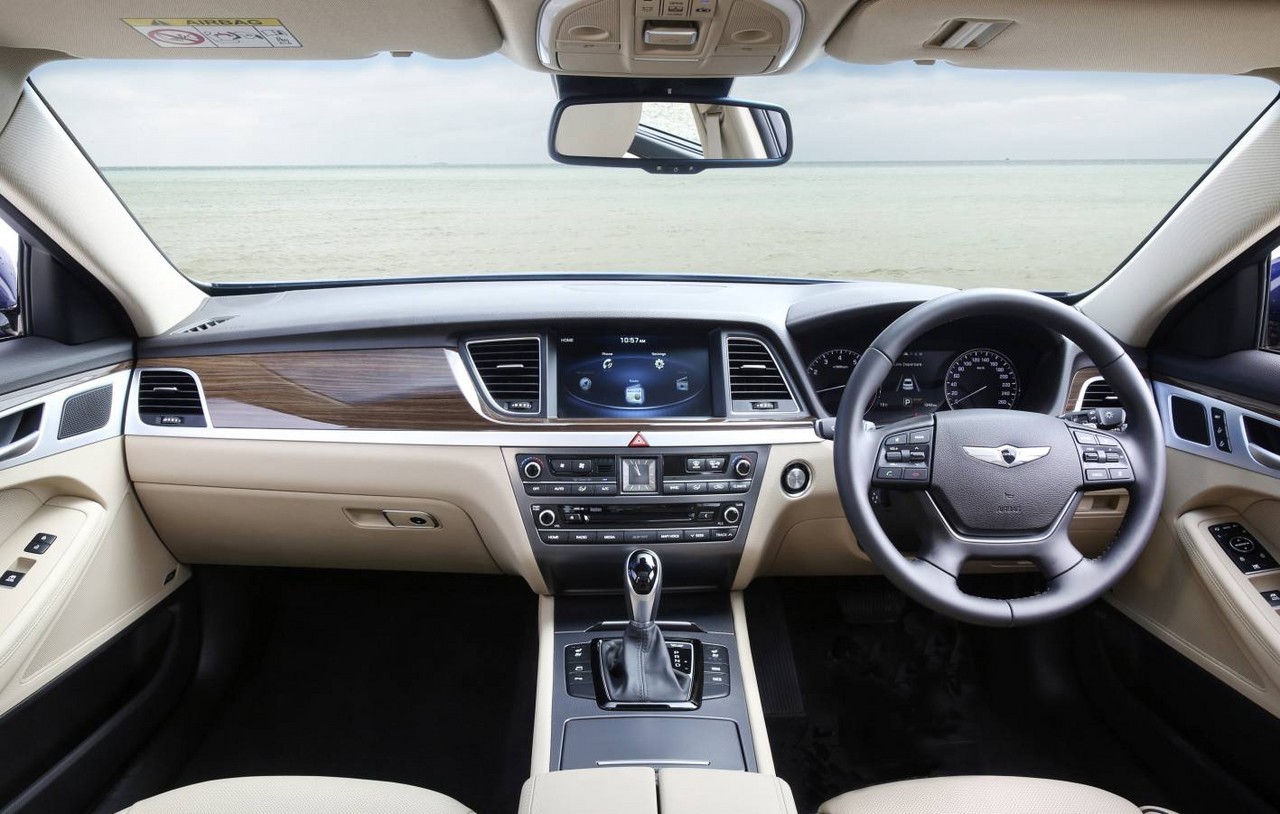
- Powerful and generally refined drivetrain
- Comfortable ride
- Spacious and comfortable interior
- Quiet, well-insulated cabin
- V6 engine is thirsty and noisy at higher rpm
- Some body roll when cornering
- Automatic transmission indecisive at low speeds
- Cheap interior switchgear
Overview
Released in Australia in November 2014, the Hyundai DH Genesis was a large, rear-wheel drive sedan. Manufactured in Ulsan, South Korea, the DH Genesis was powered by a 3.8-litre V6 petrol engine that was mated to an eight-speed automatic transmission.
G6DJ Lambda V6 engine
The 3.8-litre G6DJ ‘Lambda’ V6 engine had an aluminium block and cylinder head, double overhead camshafts (chain-driven), direct fuel injection, four valves per cylinder, variable intake and exhaust valve timing (Dual Continuously Variable Valve Timing, D-CVVT), a three-stage variable intake system and a compression ratio of 11.5:1.
With its eight-speed ‘Shiftronic’ automatic transmission, the DH Genesis could accelerate from rest to 100 km/h in 6.5 seconds. Over the combined ADR 81/02 test cycle, fuel consumption was 11.2 litres per 100 km.
| Engine | Trans. | Peak power | Peak torque | |
|---|---|---|---|---|
| Genesis | 3778 cc G6DJ petrol V6 | 8sp auto | 232 kW at 6000 rpm | 397 Nm at 5000 rpm |
Dimensions
The Hyundai DH Genesis was 4990 mm long, 1890 mm wide (excluding mirrors), 1480 mm tall and had a 3010 mm long wheelbase; its drag coefficient was 0.26 Cd. Kerb weight ranged from 1890 kg for the standard Genesis to 1995 kg for Genesis models with the Ultimate Pack.
Steering and suspension
The Hyundai Genesis had electric power-assisted steering (Hyundai’s Rack-mounted Motor Driven Electric Power Steering or R-MDPS) and five-link front and rear suspension with coil springs and electronically-controlled shock absorbers (Continuous Damping Control, or CDC). Hyundai Australia’s engineering team also provided the Genesis with a unique suspension tune for Australian conditions.
Safety equipment
Standard safety equipment for the Hyundai Genesis included dual front airbags, a driver’s knee airbag, front and rear seat-mounted side (thorax) airbags, full-length curtain airbags, ABS, electronic brake force distribution, brake assist, electronic stability control, traction control and front seatbelts with pretensioners and load limiters.
As standard, the Hyundai Genesis was also fitted with the following active safety technologies –
- Autonomous Emergency Braking (AEB): used a camera mounted on the windscreen and a radar sensor in the front grille to scan the road ahead. If sensors detected that the Genesis was rapidly approaching a vehicle, the AEB system would warn the driver and automatically apply the vehicle’s brakes;
- Smart Cruise Control (SCC): using a sensor in the front grille, SCC provided autonomous braking and acceleration in stop-start traffic;
- Lane Departure Warning (LDW): the front-mounted camera could detect if the Genesis departed from its lane without indicating. If this occurred, the driver would be alerted via an audible tone and steering wheel vibrations;
- Smart High Beam (SHB): the SHB system could detect oncoming traffic at night and automatically dip the high beam headlights to reduce glare. When no vehicles were detected, the system would reactivate the high beam headlights; and,
- Active Bonnet: in the event of a pedestrian collision, the bonnet would automatically rise to increase the distance between it and hard points in the engine bay, and provide a cushioning-effect on impact.
Beyond this, the Sensory Pack added the following –
- Lane Change Assist (LCA): performs a similar function to the LDW, but could control the steering wheel to prevent lane departure when a vehicle approached the edge of its lane;
- Blind Spot Detection (BSD): used radar sensors in the rear bumper to warn the driver of an approaching vehicle via an indicator both on the head-up display and side mirrors. If the driver activated the indicator and attempted to change lane, the BSD system would issue an audible warning and steering wheel vibration; and,
- Rear Cross Traffic Alert (RCTA): scanned areas on each side of the vehicle when the driver was reversing out of a parking space and would warn of approaching traffic.
Brakes
The Hyundai DH Genesis had 345 mm by 30 mm ventilated front brake discs with four-piston fixed monobloc calipers and 314 mm by 13 mm solid rear discs with single-piston sliding calipers.
ANCAP crash testing
In ANCAP crash testing , the Hyundai DH Genesis received a five star adult occupant protection rating with a score of 36.88 out of 37. In the offset crash test, protection of the front occupants was generally rated as good, although protection of the driver’s chest was rated as adequate (i.e. a slight risk of serious injury). In the side impact and pole tests, however, maximum points were awarded.
Features: Hyundai Genesis
Standard features for the Hyundai DH Genesis included 18-inch alloy wheels with 245/45 R18 Hankook tyres (with a space-saver spare), a seventeen speaker Lexicon sound system with a CD player, auxiliary inputs (3.5 mm/USB/iPod), Bluetooth connectivity and audio streaming, satellite navigation with a 9.2-inch 720p monitor, dual-zone climate control air conditioning, leather seats, twelve-way power adjustable and heated front seats, cruise control, a rear view camera, High Intensity Discharge (HID) headlights, automatic headlights, rain-sensing wipers, a rear seat ski port, steering wheel gearshift paddles, remote central locking with proximity key (for keyless entry), power adjustable mirrors with heating and folding functions, power windows, tilt and telescopic steering column adjustment, push-button start, three 12 volt power outlets, an electrochromatic rear-view mirror, tyre pressure monitoring, ambient lighting, illuminated vanity mirrors, courtesy lamps, stainless steel scuff plates, a trip computer, an alarm and immobiliser.
Genesis Sensory Pack
Compared to the standard Genesis, the Sensory Pack added a sixteen-way power adjustable driver’s seat, premium leather seats, LED fog lamps, cluster ioniser for the climate control system, an Around View Monitor (AVM) system with four cameras (front, sides and rear) that could provide a bird’s eye view of the vehicle and its surrounds, a power adjustable steering column, driver memory settings (for the seat and steering column) and electrochromatic door mirrors.
The Sensory Pack also included a head-up display (HUD) which could project a virtual image onto the windscreen using a system of mirrors and a TFT LCD. As such, the HUD could display information such as current speed, SCC status, navigation, BSD and LDW data.
Genesis Ultimate Pack
In addition to the features included in the Sensory Pack, the Ultimate Pack added 19-inch alloy wheels with 245/40 R19 front and 275/35 R19 rear Dunlop tyres, ventilated front seats, heated rear seats, a panoramic glass sunroof, noise-reducing glass, soft-close doors, a power-operated boot, illuminated front scuff plates, rear door curtains and a seven-inch colour LCD Supervision cluster.
Related links
- Brochure: Hyundai DH Genesis (November 2014)
- Specifications: Hyundai DH Genesis (November 2014)
- Hyundai Motor Company Australia: Hyundai Genesis
- Wikipedia.org: Hyundai DH Genesis
- Behind the Wheel: 2015 Hyundai Genesis Ultimate Pack Review
